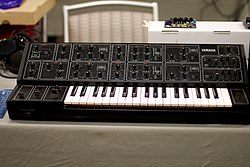Engineering:Yamaha CS-15
 Yamaha CS-15 | |
| Dates | 1979-1982 |
|---|---|
| Price | £799 GBP $999 United States dollar |
| Technical specifications | |
| Polyphony | Monophonic |
| Timbrality | 2 part [1] |
| Oscillator | 2 (Pulse, Saw Down, Sine, Square, White Noise) |
| LFO | 1 (triangle, saw and S&H waveforms)[2] |
| Synthesis type | Analog[3] Subtractive |
| Filter | 2 (12dB Slope (2-pole), Band Pass, High Pass, Low Pass, Resonance) |
| Attenuator | 2 (ADSR) |
| Storage memory | None |
| Effects | None |
| Input/output | |
| Keyboard | 37 keys[1] |
| Left-hand control | Pitch bend |
| External control | CV/gate |
The Yamaha CS-15 is a Monophonic analog synthesizer produced by Yamaha from 1979 to 1982.[4]
In the CS series, the CS-5, CS-10, CS-30 and CS-30L were similar in sound, structure and design (the all had similar black casing). The 5 and 10 had a single oscillator and one multimode (lowpass/bandpass/highpass) filter, whereas the 15/30/30L had two oscillators that could be routed in various ways through two multimode filters.[5]
Architecture
It features two voltage-controlled oscillators, two 12 dB/Oct multi-mode Voltage-controlled filter (Low-Pass, High-Pass or Band-Pass), two ADSR envelopes and a Low-Frequency Oscillator. It also features a White noise and an external-in for processing other sounds.[6]
The CS-15 offers a great flexibility with various routing possibilities to the filters and envelopes. You can, for example, rout VCO 1 to both VCFs and the VCFs to any of the envelopes positive or negative voltage.
It's actually a duophonic / bitimbral synthesizer but you have to connect it two separate CV/Gate controls (Hz/V like Korg synthesizers not V/Oct) to play the extra voice.
Notable users
The CS-15 was used by several bands in the early 1980s. The Human League made prominent use of the instrument on their album Dare.[6] Marillion used a CS-15 on their first full-length album, Script for a Jester's Tear.[7] It was also used by Astral Projection, Somatic Responses, The Moog Cookbook, and Vince Clarke (of Erasure).[2]
Boyd Jarvis, a producer and early pioneer of house music, started out with a CS-15 as his first synthesizer.[8][9]
See also
References
- ↑ 1.0 1.1 SynthArk, Designed by www.1234.info / Modified. "CS-15" (in en). http://www.synthark.org/Yamaha/CS-15.html.
- ↑ 2.0 2.1 "Yamaha CS-15 | Vintage Synth Explorer" (in en). http://www.vintagesynth.com/yamaha/cs15.php.
- ↑ "Yamaha CS-15 Synthesizer" (in en-US). https://encyclotronic.com/synthesizers/yamaha/cs-15-r383/.
- ↑ "Top Ten Most Underrated Synths - Page 9 of 11 - Attack Magazine" (in en-US). Attack Magazine. 2012-09-19. https://www.attackmagazine.com/reviews/the-best/top-ten-most-underrated-synths/9/.
- ↑ Vrazo, Matt (2019-07-12). "Yama-huh? Esoteric design aspects of Yamaha CS synths (Part 1)" (in en-US). https://greatsynthesizers.com/en/general/yama-huh-esoteric-design-aspects-of-yamaha-cs-synths-part-1/.
- ↑ 6.0 6.1 "Top Ten Most Underrated Synths". Attack Magazine. 19 September 2012. https://www.attackmagazine.com/reviews/the-best/top-ten-most-underrated-synths/9/. Retrieved 25 August 2016.
- ↑ Script for a Jester's Tear (Media notes). EMI Records. 1983. EMC 3429.
- ↑ "Boyd Jarvis". https://jahsonic.com/BoydJarvis.html.
- ↑ "Boyd Jarvis (uncut): An interview by Matt Anniss" (in en-GB). 2018-03-11. https://inn8.net/interview-boyd-jarvis-by-matt-anniss/.
 |


